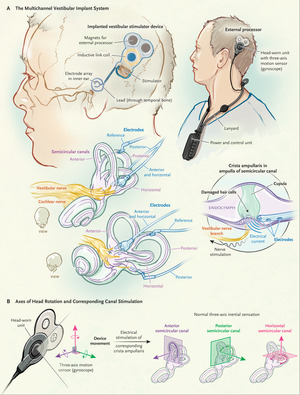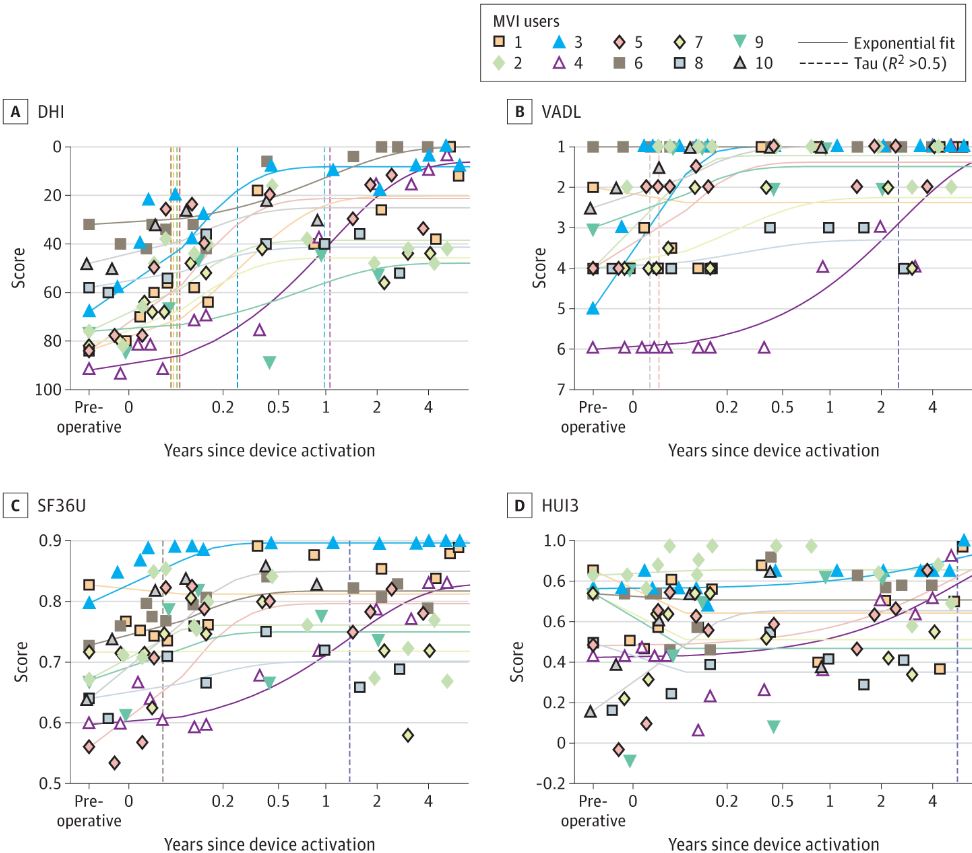A new study published in JAMA Otolaryngology-Head & Neck Surgery suggests that a vestibular implant system may provide significant benefits for individuals suffering from bilateral vestibular hypofunction (BVH), a condition that impairs balance and spatial perception.
The study examined outcomes from the Multichannel Vestibular Implant (MVI) system, an implanted device that aims to treat BVH by continuously providing artificial sensory input through electrical stimulation of the semicircular canals.
BVH severely affects an estimated 64,000 adults in the U.S. and 1.8 million worldwide. The condition increases risk of falls by 31-fold and leads to blurred vision, chronic dizziness, fatigue and reduced quality of life. Current treatment options are limited, often inadequate, and have not changed much over the past century.
Vestibular Implant to Treat Bilateral Vestibular Hypofunction

COMPONENTS AND MECHANISM OF A VESTIBULAR IMPLANT. IMAGE CREDIT: NEJM
The MVI Early Feasibility Study is an ongoing clinical trial evaluating the MVI system in adults with severe or profound BVH for at least one year who remain symptomatic despite standard treatments like vestibular rehabilitation therapy.
The study included 10 participants who received unilateral MVI implantation and 10 control participants with BVH who completed surveys but did not undergo implantation.
Patient-reported outcome surveys on dizziness, disability and health-related quality of life were completed before and after implantation. Outcomes were compared between the MVI and control groups.
At 6 months post-implantation, MVI recipients reported significant improvements in dizziness, disability and quality of life compared to the control group, which did not report meaningful improvements.
Importantly, MVI users maintained these benefits over follow-up assessments from 1.5 to 6 years, providing key evidence that improvements were due to the device rather than placebo effect. Most MVI users reached a plateau in benefit around 6 months after implantation.
By one measure, MVI users gained an estimated 1.7 additional years of healthy life compared to the control group over their lifetime.

Time course of benefit was estimated for each participant’s responses to the Dizziness Handicap Inventory (DHI) (A), Vestibular Disorders Activities of Daily Living (VADL) (B), Short Form-36 Utility (SF36U) (C), and Health Utilities Index Mark 3 (HUI3) (D). Axes in panels A and B are inverted so that the direction of improvement is upward for all panels. The time constant tau was derived from the shown exponential fit that starts at each participant’s preoperative value and grows or decays to a final value bounded by the survey’s maximum and minimum. The vertical dashed lines show the time constants estimated for the fits in which R2 > 0.5. Best fit time constants show that most participants perceived benefit after less than 0.5 years of device use, with 2 participants having time constants of longer than 1 year of device use to see benefit. Credit: Ayiotis, et. al, JAMA
MVI Benefits Show Promise
The results suggest MVI vestibular implantation can provide substantial and sustained benefits for individuals with severe BVH who remain impaired despite standard rehabilitation therapy.
However, counseling should set appropriate expectations, as the degree and pace of improvement varied across participants, similar to cochlear implantation for hearing loss.
While the initial findings show promise, further research involving larger patient cohorts and longer follow-up periods is necessary to fully establish the safety and efficacy of the MVI system. Additionally, the estimated cost of $100,000 for the device and implantation procedure might pose a barrier to access for some individuals.
For patients grappling with chronic and treatment-resistant dizziness, these findings offer a glimmer of hope that vestibular implantation could eventually become a widely accessible option, potentially restoring balance and enhancing overall quality of life.
This study contributes to the mounting body of evidence suggesting that prosthetic vestibular stimulation could address a significant unmet need among those afflicted with bilateral vestibular hypofunction.
Further research endeavors and advancements in technology could pave the way for more widespread adoption of vestibular implantation, offering relief to those suffering from BVH.
Reference:
- Ayiotis AISchoo DPFernandez Brillet CLane KECarey JPDella Santina CC. Patient-Reported Outcomes After Vestibular Implantation for Bilateral Vestibular Hypofunction. JAMA Otolaryngol Head Neck Surg. Published online February 01, 2024. doi:10.1001/jamaoto.2023.4475
**Readers may also be interested in the video below from Johns Hopkins:
Source: JAMA Otolaryngology-Head & Neck Surgery






